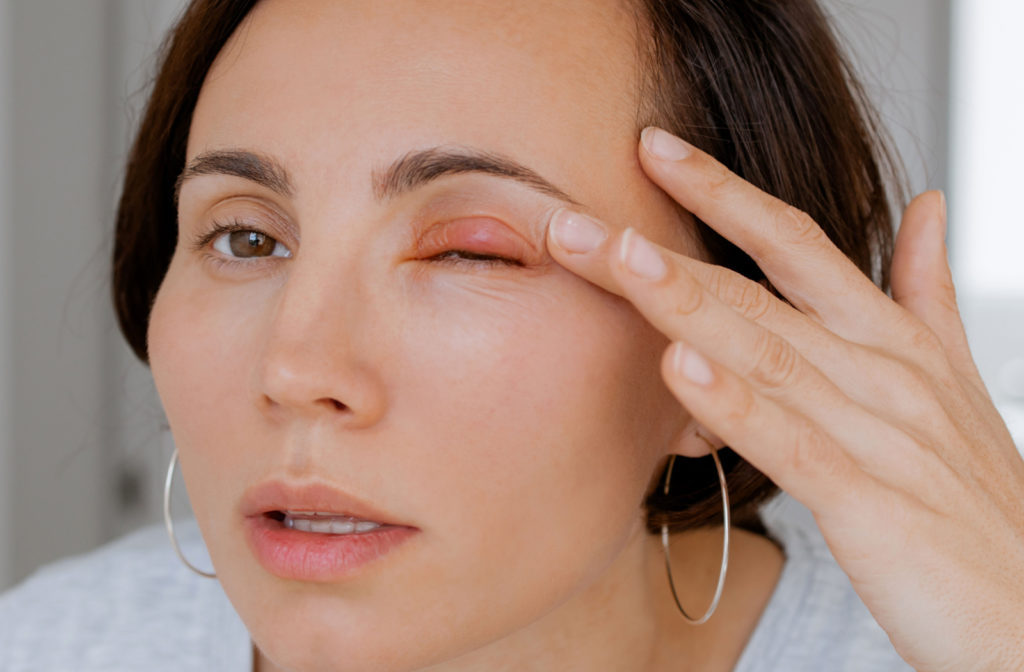If you experience eye redness and swelling, the first thing that often comes to mind is pink eye. But pink eye and styes are two conditions that can be indistinguishable, especially early on.
Your eye doctor can help diagnose which eye condition you have by discussing your symptoms and performing an eye exam. The difference between pink eye and styes is that a stye has a red lump or bump on the eyelid, and pink eye does not. Pink eye and stye have similar symptoms but different causes and treatments.
What Is Pink Eye & Stye
Pink eye, also known as conjunctivitis, is inflammation of the conjunctiva. The conjunctiva is the thin, clear tissue covering the white part of your eye and lines the inside of your eyelid.
Some forms of pink eye, such as bacterial and viral, can be contagious and spread from one person to another through:
- Touching or shaking hands
- Coughing and sneezing
- Touching something with germs on it, then touching your eyes
A stye, also called a hordeolum, is a bump on your eyelid. It resembles a small pimple on the edge or inside of your eyelid. Styes can be painful but aren’t contagious. You are more at risk of getting a stye if:
- You had one before
- You wear contact lenses
- You aren’t keeping your eye area clean
- You use old or contaminated eye makeup
- You have blepharitis
- You have other conditions such as rosacea, seborrheic dermatitis, or diabetes
What Causes Pink Eye & Stye?
The most common causes of pink eye are: viruses, bacteria, allergens, or irritants. Other less common causes can include the following:
- Chemicals
- Contact lens wear
- Foreign bodies in the eye, for example, dirt or an eyelash
- Indoor and outdoor air pollutants, such as smoke or dust
- Fungal infection
- Ameba and parasites
A stye results from an infection of the oil gland in the eyelid or hair follicle. Bacteria is usually the cause of the infection and can result from sleeping with makeup, frequently rubbing your eyes, and wearing disposable contact lenses beyond their shelf life.
Symptoms of Pink Eye & Stye
The symptoms of pink eye can include:
- Pink or red colour in the whites of the eye
- Swelling of conjunctiva or eyelid
- Foreign body sensation
- Itching and irritation
- Tearing
- Discharge
- Crusting
- Contact lens discomfort
Symptoms of styes can include the following:
- Swelling
- Redness
- Pain or tenderness in the eyelid
- Gritty feeling in the eye
- Tearing
- Crusting
- Sensitive to bright light
Treatment for Pink Eye & Stye

Pink eye and stye are treatable with over-the-counter medication or at-home remedies. However, it’s essential to visit your eye doctor for proper diagnosis and treatment by determining the underlying cause.
Treatment for pink eye can include:
- Cold compress to relieve inflammation
- Artificial tears to relieve dryness
- Prescription eyedrops for infection or inflammation
- Stop wearing contact lenses until your eye doctor gives the okay
Treatment for styes can include:
- Warm compress on eyelids a few times a day
- Wash your hands often
- Wash your face and eye area daily
- Refrain from touching the eye area
- Avoid popping or squeezing the stye
- Avoid wearing makeup until the stye heals
- Antibiotic cream or ointment prescribed by your eye doctor
How to Prevent Pink Eye & Styes
Anyone can get pink eye and styes. The key to prevention is eye hygiene. To prevent pink eye and styes, you can take the following precautions:
- Wash your hands thoroughly with soap and water.
- Avoid touching your face and eyes with unclean hands.
- Resist the temptation to rub your eyes.
- Clean and replace makeup products often, don’t share your makeup with others, and remove any makeup before you sleep.
- Maintain good contact lens hygiene practice and avoid wearing contact lenses past their recommended wear time or expiration date.
If you or someone in your vicinity has pink eye, maintain a safe distance and do not share anything. To prevent reinfection, wash all linen and towels and throw away any infected makeup products, disposable contact lenses, and solutions. Clean eyeglasses and extended-wear contact lenses as directed.
When to See Your Eye Doctor
If you have common symptoms such as redness, swelling, eye pain, and foreign body sensation, see your eye doctor, as some forms of pink eye are contagious. Or if you experience vision impairment, notice green or yellow pus and your eyes become more red, contact your eye doctor immediately to rule out other eye issues.
Healthy Eyes for Clear Vision
Pink eye and styes are two of the most common eye infections that can happen to anyone. They have similar symptoms but varying causes and treatments. Knowing the difference between pink eye and styes can help you get the right treatment and prevent the infection from spreading. For any signs of a pink eye or stye, book an appointment with Queensway Optometric Centre for timely diagnosis and symptom relief.


